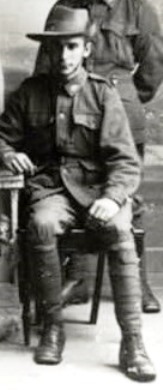Pte
Edward Joseph Foster
Informationen zu Geburt
|
Geburtsjahr: 1894 |
|
Geburtsort: Queenstown, Adelaide, South Australia, Australia |
Allgemeine Informationen
|
Beruf: Arbeiter |
Informationen zum Armeedienst
|
Land: Australia |
|
Truppe: Australian Imperial Force |
|
Rang: Private |
|
Dienstnummer: 289 |
|
Einberufung datum: 12/01/1916 |
|
Einberufung ort: Adelaide, South Australia, Australia |
|
Einheiten: — Australian Infantry, 43rd Bn. (The Hindmarsh Regiment) (Letzte bekannte Einheit) |
Informationen zu Tod
|
Sterbedatum: 04/10/1917 |
|
Sterbeort: Hill 40, Zonnebeke, Belgien |
|
Todesursache: Im Kampf gefallen |
|
Alter: 23 |
Gedenkstätte
|
Ypres (Menin Gate) Memorial Tafel: Bay 27 stone B |
Auszeichnungen und Orden 2
|
British War Medal Medaille |
|
Victory Medal Medaille |
Punkte von Interesse 3
| #1 | Geburtsort | ||
| #2 | Einberufung ort | ||
| #3 | Ort des Todes (ungefähr) |
Meine Geschichte
The former labourer Edward Joseph Foster was 22 years old and single when he enlisted the AIF on 12th Januari 1916. He served before in the Cadet Forces.
He was appointed to the 43rd Battalion (part of the 3rd Division, 11th Brigade), same as his older brother Thomas.
Other brothers in the war, were John (48th Btln) and George (32th Btln).
At 01.50 a.m. the 4th October 1917 all of the 43th Battalion was in position NW of Zonnebeke in front of Hill 40.
Private Edward Joseph Foster was part of the 43th Battalion Australian Infantry Hindmarch Regiment (11th Australian Brigade, 3th Australian Division). Before enlisting, the 23 year old Edward Joseph worked as labourer in Queenstown, Adelaide, South Australia. He served together in the same battalion as his older brother Thomas.
On the 4th October, the 43th Bn. Australian Infantry took part in the Battle of Broodseinde. The 11th Australian Brigade divided the task of the attack, where the 43th Bn. A.I.F. was responsible for the first wave. The 43th Battalion was to capture the line until Alma (D.22.c.20.40). It met its objective at 6.20am, after which it was immediately consolidated. However, the battalion suffered heavy losses before meeting its objective on Hill 40. The 42th battalion was to leapfrog through the 43th battalion. As one company missed its barrage, men from the 43th battalion joined. The second objective was reached fairly easy at 7.25 am.
According to his Red Cross Wounded and Missing file, Private Foster was killed by the concussion of a shell. He was buried where he fell near Hill 40 (Zonnebeke 28 NE.1 – D21 b c d). His body wasn’t retrieved or identified after the war. He is remembered on the Menin Gate in Ypres. His brother Thomas was wounded in the same battle and died in a dressing station the next day. A third brother John Foster, 48th Bn. A.I.F. survived the war and returned home to Australia during 1919, as did a fourth brother, George Foster from the 32nd Bn. A.I.F.
He was appointed to the 43rd Battalion (part of the 3rd Division, 11th Brigade), same as his older brother Thomas.
Other brothers in the war, were John (48th Btln) and George (32th Btln).
At 01.50 a.m. the 4th October 1917 all of the 43th Battalion was in position NW of Zonnebeke in front of Hill 40.
Private Edward Joseph Foster was part of the 43th Battalion Australian Infantry Hindmarch Regiment (11th Australian Brigade, 3th Australian Division). Before enlisting, the 23 year old Edward Joseph worked as labourer in Queenstown, Adelaide, South Australia. He served together in the same battalion as his older brother Thomas.
On the 4th October, the 43th Bn. Australian Infantry took part in the Battle of Broodseinde. The 11th Australian Brigade divided the task of the attack, where the 43th Bn. A.I.F. was responsible for the first wave. The 43th Battalion was to capture the line until Alma (D.22.c.20.40). It met its objective at 6.20am, after which it was immediately consolidated. However, the battalion suffered heavy losses before meeting its objective on Hill 40. The 42th battalion was to leapfrog through the 43th battalion. As one company missed its barrage, men from the 43th battalion joined. The second objective was reached fairly easy at 7.25 am.
According to his Red Cross Wounded and Missing file, Private Foster was killed by the concussion of a shell. He was buried where he fell near Hill 40 (Zonnebeke 28 NE.1 – D21 b c d). His body wasn’t retrieved or identified after the war. He is remembered on the Menin Gate in Ypres. His brother Thomas was wounded in the same battle and died in a dressing station the next day. A third brother John Foster, 48th Bn. A.I.F. survived the war and returned home to Australia during 1919, as did a fourth brother, George Foster from the 32nd Bn. A.I.F.
Verwandte, die auch Soldat waren 1
|
Thomas Foster
Brother |
Quellen 7
|
"Passchendaele, The Day-by-Day Account",McCarthy C., Arms&ArmourPress, London, 1995, page 98-99 Verwendete Quellen |
|
AIF Project https://www.aif.adfa.edu.au/showPerson?pid=101987 Verwendete Quellen |
|
AWM https://www.awm.gov.au/advanced-search/people?people_preferred_name=Foster+Edward+Joseph&people_service_number=289&people_unit= Verwendete Quellen |
|
CWGC https://www.cwgc.org/find-records/find-war-dead/casualty-details/923569/EDWARD%20JOSEPH%20FOSTER/ Verwendete Quellen |
|
Service Record https://recordsearch.naa.gov.au/SearchNRetrieve/Interface/ViewImage.aspx?B=4024536 Verwendete Quellen |
|
The Long long Trail http://www.longlongtrail.co.uk/army/order-of-battle-of-divisions/3rd-australian-division/ Verwendete Quellen |
|
War Diary https://www.awm.gov.au/collection/C1344151 Verwendete Quellen |
